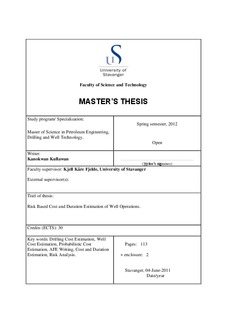| dc.contributor.author | Kullawan, Kanokwan | |
| dc.date.accessioned | 2012-11-08T10:13:40Z | |
| dc.date.available | 2012-11-08T10:13:40Z | |
| dc.date.issued | 2012 | |
| dc.identifier.uri | http://hdl.handle.net/11250/183386 | |
| dc.description | Master's thesis in Petroleum engineering | no_NO |
| dc.description.abstract | Due to high uncertainties and the cost intensive nature of well operations, accurate forecast of well cost and duration is one of the main requirements for writing an AFE and supporting decision making processes. Traditionally, the well cost has been estimated by the deterministic approach. However, this method has some limitations and the actual operating costs can significantly exceed the planned budget. Thus, the probabilistic approach of well cost estimation along with risk assessment has been developed and considered a more appropriate approach for dealing with well cost estimation.
There are many simulation tools which are available in the market. Nevertheless, the Risk€ software, developed by IRIS, is the simulation tool used here. This software also provides the function of including undesirable events into the simulation. Thus, risks associated with the well operations can be assessed effectively.
An example well model is created and the characteristics of the results are studied. Detailed analysis has been performed to observe how the changes in input parameters can affect the uncertainties and values of the simulated results. The case construction was inspired by a drilling program that was released from Statoil through the Academia program for teaching purpose.
The simulation showed that drilling and mobilization phases have the largest influence on the total well cost and duration. Besides, detailed sensitivity analysis revealed that better information of an expected range of ROP can greatly reduce the uncertainties of the results. When the expected values are analysed, the results demonstrate asymmetric behaviour. The effect on total duration and cost when the operation is slower is much greater than when it is faster.
Risk events are included in the simulation with an assumption that the problems can be solved and there is no extra cost associated with the events, only extra duration. Comparison between the standard operation plan and the risk operation plan also shows that unwanted events can drastically increase the uncertainties of the results and failure to include risk events in the forecast can lead to improper budget assigned to the project.
For future study, the software should be developed to handle more well operations scenario; such as multilateral well, lost in hole (LIH) situation, batch drilling including the effect of learning curve and the completion phases. The software could also be extended for analysing new drilling technologies. Thus, well cost and duration estimation in various situations can be performed. | no_NO |
| dc.language.iso | eng | no_NO |
| dc.publisher | University of Stavanger, Norway | no_NO |
| dc.relation.ispartofseries | Masteroppgave/UIS-TN-IPT/2012; | |
| dc.subject | petroleumsteknologi | no_NO |
| dc.subject | boreteknologi | no_NO |
| dc.subject | drilling cost estimation | no_NO |
| dc.subject | well cost estimation | no_NO |
| dc.subject | probabilistic cost estimation | no_NO |
| dc.subject | risk analysis | no_NO |
| dc.subject | cost and duration estimation | no_NO |
| dc.subject | AFE writing | no_NO |
| dc.title | Risk based cost and duration estimation of well operations | no_NO |
| dc.type | Master thesis | no_NO |
| dc.subject.nsi | VDP::Technology: 500::Rock and petroleum disciplines: 510::Petroleum engineering: 512 | no_NO |
